Board in the Library, Act 4
Interactions, Lamentations, and Vanquished Foes
We are pleased to publish this article, the fourth in a six-part series on board game programming in public libraries, from John Pappas, the Branch Manager at the Bensalem Branch of the Bucks County Free Library System. (Read Part One | Part Two | Part Three | Part Four | Part Five | Part Six). See also webinars with John on boardgames: The Golden Age of Gaming: Board Games for Grown-ups and Whose Turn Is It, Anyway? Online Board Gaming and Libraries.
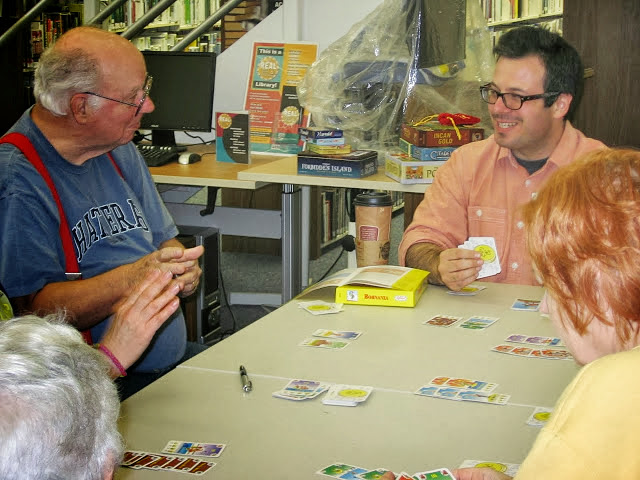 Introduction
Introduction
All games can facilitate social interaction. Even when games are meant to be played in a solitary fashion, they still have the potential for players to interact with each other. This interaction can be subtle, (explaining or teaching the rules of a game), meta (“Bob always does this strategy to win Alien Frontiers, watch him!”), or as a necessary part of the gameplay (such as bidding, negotiating or bluffing). Player interaction is one of the things that make board games (and gaming in general) so attractive to so many people. In this article we will attempt to identify some of the attributes of player interaction in board games as well as discuss different archetypes of gamers which may show up at your gaming event.
When asked why I enjoy playing board games, I state that the social interaction is one of the sole reasons I play. For this reason I tend to align myself with games that encourage a high level of social interaction (generally friendly interaction, as I am not a hugely competitive player). However, the person next to me could be competitive and the person across from me could prefer games with no player interaction at all! This can be a challenge for librarians and libraries trying to implement gaming groups as a part of their programming calendar, or starting to embrace board games.
For every gamer, their game.
Many games require or are optimally played with certain types of social interactions or, potentially, types of players. Discovering where your patron expectations intersect with the type of games you provide can be a complex undertaking. Striking the right balance can provide a satisfying and immersive experience for your players while the wrong games can potentially lead to frustration. Additionally, when considering whether to choose a game for a library it is important to take into consideration the space and proximity of other patrons and the type of interaction the game may produce (and thus level of table-talk and accompanying noise).
This post will discuss a few different games and the type of interaction they potentially produce.
First, ask yourself a few questions.
- How much noise is appropriate in your library?
- Is your library a “loud” or “quiet” library?
- What space are you considering – an open, accessible space (common area) or closed, exclusive space (community room)?
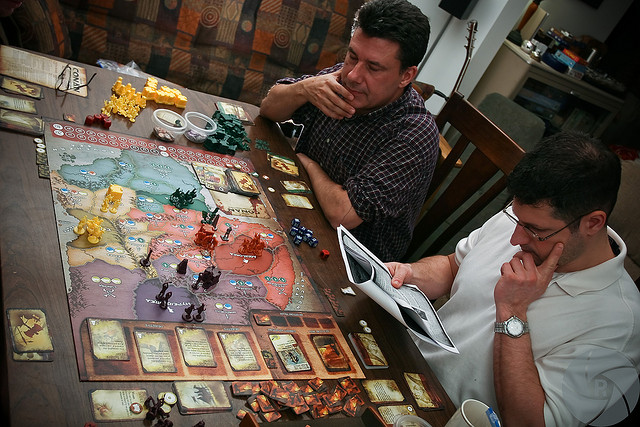 Social Interaction
Social Interaction
Social interaction can be minimal. A player's head can be buried into a hand of cards or enveloped by a player board, lost in contemplation. Interaction can be high and loud, competitive or cooperative in nature, with players talking, planning, bluffing, bidding, or negotiating across the table. Some games provide a type and level of interaction where a player’s decisions directly or indirectly affect (or hinder) another player and can potentially encourage conflict (which is fine!).
To encourage new players, I have most of my library board gaming events out in the open – three tables right in the middle of the library’s common area so as patrons come in they can see us playing. The level and type of interaction presented help sway patrons to stand and watch, jump into a game, or come back next week to play.
Or it may scare them away.
All games involve player interaction.
Some games make interaction a primary component of gameplay and others as a supplement to other mechanics. A newbie to board games may walk into a group playing high interaction games like “A Game of Thrones,” “Cosmic Encounter” or “Diplomacy” - where negotiation, bluffing, player elimination, and deceit are necessary to the full experience of the game - and be immediately turned off or intimidated enough to avoid playing. This is not to say that these elements are bad; they are not. However, they may not be welcoming or accessible to new players. In a similar vein a game like “Dominion,” where players are playing largely independent of other players, may look exceedingly dull with little to no talking, active competition, or interaction with other players -- just the sound of cards flipping and the occasional “squee!”.
Balance and community are pivotal to the success of a library gaming program. Knowing what your community prefers will help you succeed.
As a general rule I prefer to start with games that contain a moderate amount of player interaction – what I would call “friendly competitive,” where your decisions affect other players but affect them indirectly rather than grinding their head in the dirt. But in the end, it is your responsibility to listen to, understand, and respect the wishes and needs of your patrons.
So variety being the spice of life, let us get started with a selection of solitary games.
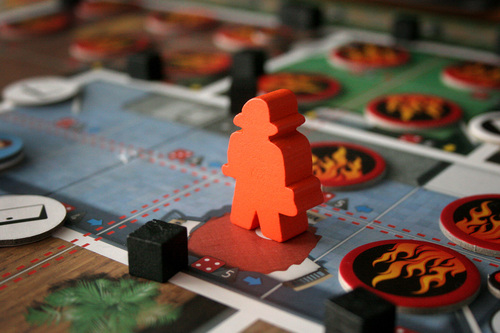 Solitary Games
Solitary Games
These are games that minimize interaction and tend to focus on building your own deck of cards or tableau independent from the action of other players. In this “alone together” situation, players optimize a personal board, complete for goals, claim points, make sets of cards, or race against a clock. Players tend to completely ignore other players and are unable to affect other players by their decisions (granted, there is a range here). In the following quote board game aficionado Quintin Smith states that he is not a huge fan of these games:
Games where, fundamentally, each player is off in their own world, worrying about their own problems, and not in anything resembling dynamic conflict or co-operation with their friends. I find them dull. But I’d go further than that. I’d actually call them failures of design. -Quintin Smith, Shut Up and Sit Down (Hater of Solitary Games).
I think Quintin is overstating it a bit there since games like “Dominion” and “7 Wonders” have a large following despite their tendency to be quiet and lack player interaction. These games can be engrossing and rich; punctuated with occasional outbursts of glee but still sombre enough for those that don’t attend a local gaming group in a tutu and bow-tie (In case you are wondering, I did once.) But, I admit, even those outbursts are rare.
This style of game often has a specific goal to achieve, such as claiming the most points or being the first to complete a full board. This goal could be decently completed without anyone else around or even caring what the rest of the players are doing. If you are still recovering from horrible games of Monopoly or are an introvert, these games can be quite appealing. The deep focus is engaging, and developing a tableau is rewarding. Optimizing resources provides a challenge. Quiet and reserved, these games shouldn’t be overlooked. However, new players will not likely wish to be included. It seems too closed off, private, and guarded. I tend to limit these games to the sidelines for attendees to pull if they wish, and I don’t feature them at the main table.
I leave the main table reserved for friendly competition.
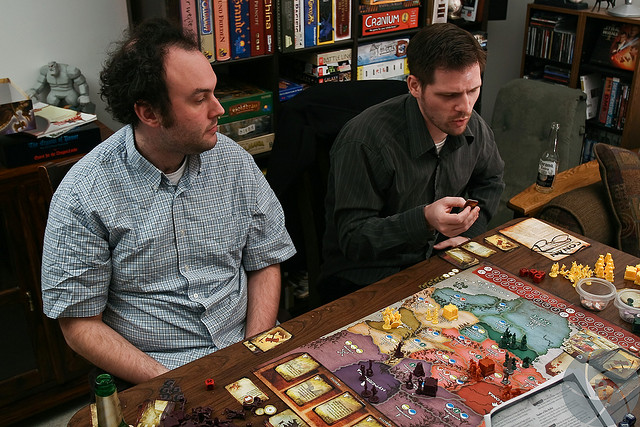 Friendly Competition
Friendly Competition
Some games encourage interaction through a shared board and personal objectives. These combined elements of shared and solitary play create a diffused sense of competition. Games which feature competition for specific areas to control, a race towards a singular goal, or competition over limited or optimal resources fall into this category. The game-play is not particularly cut-throat as you are not purposely playing in a manner to trip-up other players (at least not often). In addition, while resources are often limited, players are rarely denied access to a resource, but can make it more costly if others are interested in acquiring the same thing.
Good examples of this type of game are “Power Grid“, “Carcassonne“, “Agricola“ and “Ticket to Ride.” Each provides a limited amount of resources, choice areas of land, and a level of interaction to achieve personal goals. You can make it difficult for other players while furthering your own goals but the interaction is indirect rather than direct so the competition remains friendly and diffused. You are still doing something to the board or limiting resources you know someone needs rather than, I don’t know, stealing from their supply or blowing up their home planet. These games develop a consistent, pleasant hum of table-talk which is welcoming for both new and experienced gamers. Voices tend to be charged with a moderate level of excitement with limited gloating or sullen silence. What makes these types of games so wonderful for a library is that the interaction will bring a curious crowd. The game-play looks fun and inviting. The people seem engaged and friendly. Most gateway-games would fall into this category.
Then keep a few direct competition games for the experienced gamers or adventurous newbies.
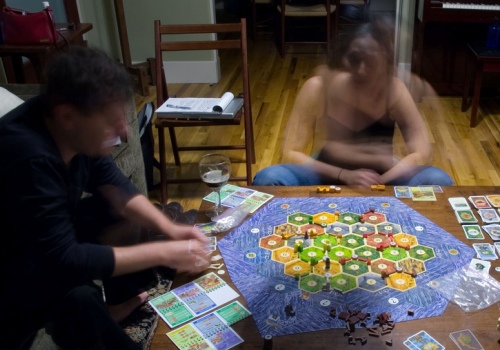 Direct Competition
Direct Competition
Games where the main mechanism is confrontation with another player would be included in this category. Game-play can be cut-throat and vicious. Players are often rewarded by tripping-up, deceiving, or attacking other players. Conflict is a primary component of the game where players keep other players from specific item or goals. “The Settlers of Catan“, “A Game of Thrones“, “King of Tokyo,” ”Small World“ and “Diplomacy” are all good examples of games where direct competition and conflict are integral aspects of the game. These games tend to be the ones that will elicit loud exclamations of the four-letter nature and can seem very intense to curious onlookers. When I feature games that contain a large amount of direct competition, I also moderate the game closely to ensure a pleasant experience for everyone.
The most engaging aspect of these games comes from affecting other players in a manner to cause them to lose. While this is fun and enjoyable, it can be off-putting to some people and not particularly welcoming to a group of strangers or inexperienced gamers.
So, be sure to balance it out with some cooperative interaction.
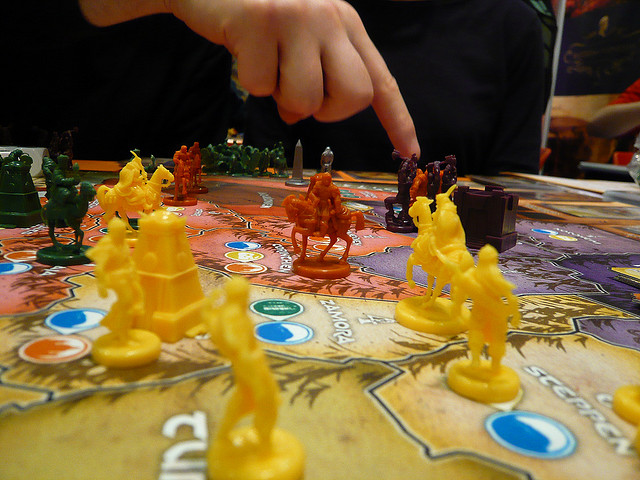 Cooperative Interaction
Cooperative Interaction
It may not be surprising that I tend to favor cooperative games at the library because the nature of the game encourages players to work together towards a goal. They encourage players to examine all the roles of the game and the scenario presented in order to ensure success for everyone. Examples of these types of games include Pandemic, Castle Panic, Forbidden Island, Hanabi, Eldritch Horror, and Flash Point: Fire Rescue. In each of these games, interaction is required but without the competition.
The games tend to be very deliberate with plenty of collaboration and table-talk over which decisions are best at any given point in the game. Players will pose questions and present scenarios throughout the game with rare moments of silence. They can end with a “doom silence” when everyone realizes that there is no way to win a particular scenario; we are all going down with the ship, being eaten by Cthulhu, or stuck under the rubble of a collapsed building.
Be warned! While it seems as if all the interaction in a cooperative game is positive, they can fall victim to the “alpha gamer syndrome” where despite all players working together towards a common objective and struggling together to win, the loudest or most experienced person at the table begins to dictate the moves of everyone else. This can be detrimental to the overall enjoyment of the game, and while I love these games, I tend to moderate them just as much as games with direct conflict.
"Gaming isn't about rolling dice and moving your piece around a track. Gaming is about interaction, decisions, and social skills." -Alan Moon, designer of Ticket to Ride.
Personality vs. Game Design
Richard Bartle, a game designer, created a variety of player types which are fairly well known to those who design games. These player types relate very well to the types of player interaction I described above. So not only should you look at the games to see what kind of interaction they encourage but you should also look at your players. Bartle’s model delineates players on two different axes which measure the player’s preference in interacting with the game versus the player’s preference in interacting with the players. Then in each quadrant, Bartle provides a player type.
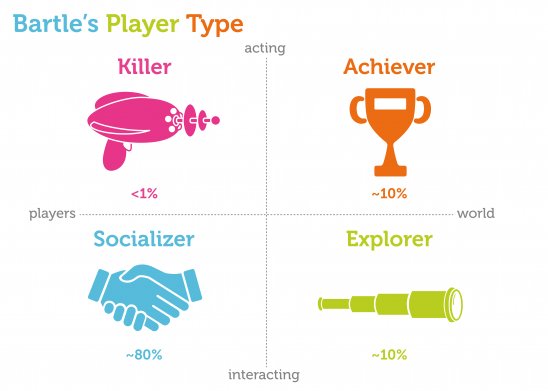
Image via: Gamification at Work by Janaki Mythily Kumar and Mario Herger.
Link: https://www.interaction-design.org/books/gamification_at_work/chapter_3_player.html
In the upper left-hand corner are the “Killers.” These players prefer to act directly upon other players. They don’t want to optimize the rules or play a solitaire game. They want to negotiate, betray, bluff and backstab. In a poker game, these would be the players who insist on playing not the cards in their hand, but the tells and personalities of the other players, in order to win. They prefer direct competition. Killers want to win or, more appropriately, they want to beat you into the dirt and never let you forget it.
In the upper right-hand corner you have “Achievers.” These players’ interests lie in acting on the game board rather than on players. These are usually the more experienced or serious gamers who prefer strategic thinking in order to win a game. They are not particularly interested in player interaction except in order to better their game or further their goals. Achievers will likely prefer any level of social interaction with an emphasis on games which mitigate luck or alliances. Solitary games are completely fine and, in a cooperative atmosphere, Achievers will likely attempt to dominate a game with their own preferred strategy. Achievers want points, property, and victory.
In the lower left-hand corner are the “Socializers.” These players prefer interacting with the players rather than the game. They spend time chatting and talking about the game (or other things) with their fellow players. Socializers are less concerned with rules, strategy, or winning and prefer to focus on the interactive nature of the other players. For Socializers, the game is just a tool in order to interact with other people. Their preference will be for friendly competitive and cooperative games since these encourage discourse. They will not gravitate towards the highly competitive games (such as one with player elimination) due to their ability to empathize with other players. Socializers just want to be friends.
In the lower right-hand corner are the “Explorers.” These players’ interests lie in interacting with the game. So their emphasis is not on achieving or winning but exploring and discovery. These players will experiment with strategies and tactics to see what they do rather than to actually win or optimize a game. These players prefer more “what-if” scenarios and will likely be more open to luck and player interaction without mitigating their love of strategy and experimentation. Explorers want to see what the game can do.
As with many categories, these are not cut and dry or absolute classifications. The element of interaction between players will vary with the players’ personality, the game’s mechanisms and, I don’t know, how much coffee you had before the game. One expressive person can make a solitary game very interactive and one competitive apple can ruin the bunch. Different players will want to have different experiences with the games they play. However, a good moderator can make anyone feel included in even the most competitive game. When I host a game session at the library, I do a few things:
Moderate. What do I moderate? Rules, behavior and fun. That is right...I moderate fun.
Expectations on behavior should be obvious to everyone.
Encourage non-players to team up with experienced ones.
Provide a supportive environment for new and a challenging one for experienced players.
LEniency for mistakes or confusion.
Smile and use humor. Have fun. Laugh.
Also, part of the fun of playing games is to mix up the levels of interaction throughout an event. Start off with a game like Mascarade, Panic on Wall Street or Ladies and Gentlemen where player interaction is high and loud but friendly. Then move to a cooperative game like Pandemic (if you prefer things thinky and strategic) or Hanabi (if you prefer things simple and short) or Escape: The Curse of the Temple (if you like things insane and hurried) to strengthen our familiar bonds. Afterwards dive into the world of Lifeboat and make some memories (and a few enemies)!
In the end you will discover your group will have a variety of preferences. In my group, Mary loves to play worker-placement games with very little player interaction but will beam and smile throughout it. I love social games that encourage, nay, require people to interact with each other. Other players prefer games that thrive off of friendly competition and rewards strategic thinking rather than tactical alliances. The interplay between a game and the people playing provides a myriad of experiences. Enjoy them all! Crush your enemies, see them driven before you, and hear the lamentation of their significant others!
 Congratulations, you have vanquished this article!
Congratulations, you have vanquished this article!
You can power-up to the next article! If you want to interact with me on all things library, board gaming, or the intersection of the two then you can find me on Twitter.
John Pappas is the Branch Manager at the Bensalem Branch of the Bucks County Free Library System. He enjoys talking about emerging technologies, gaming, public librarianship, outreach, and zen.
